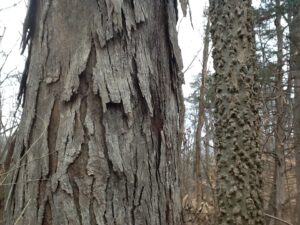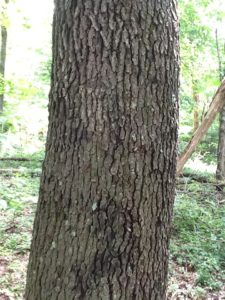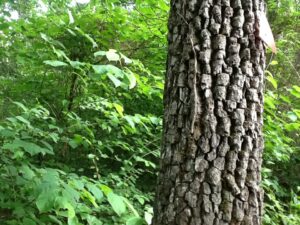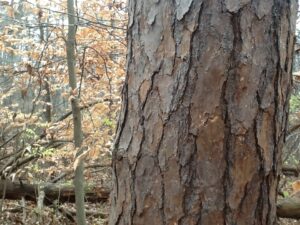By Wren Smith
 Bernheim seems suspended between winter and spring, and the trees along the Bent Twig Trail are holding next year’s crop of leaves and flowers in tightly clinched winter buds. In a few weeks these buds will start visibly swelling and become star performers in spring’s visual pageantry, promising to open a bit each day in celebration of the return of light and warmth. But for now, as we anticipate another winter snow, it seems fitting to enjoy and notice the distinctive bark from several trees along this trail. Such observation helps us experience our hikes and time outside more fully.
Bernheim seems suspended between winter and spring, and the trees along the Bent Twig Trail are holding next year’s crop of leaves and flowers in tightly clinched winter buds. In a few weeks these buds will start visibly swelling and become star performers in spring’s visual pageantry, promising to open a bit each day in celebration of the return of light and warmth. But for now, as we anticipate another winter snow, it seems fitting to enjoy and notice the distinctive bark from several trees along this trail. Such observation helps us experience our hikes and time outside more fully.
The shagbark hickory, Carya ovata, is appropriately named with its large plates of shaggy looking bark. Not only do these trees provide food in the form of oil and protein rich nuts, but creatures such as flying squirrels, moths and bats sometimes seek shelter under the shaggy plates. As I mentioned in a post several months ago, it’s an unlucky moth that attempts to hunker down under the same piece of bark as a bat.
The smaller tree in the above photo is a hackberry, Celtis sp. As a genus hackberry is easy to identify with its characteristic warty bark. Hackberry and sugarberry, Celtis laeviagata, a similar species produces small hard round fruits or drupes that provides food for wildlife and was used by early Americans in a type of trail food known as pemmican. Most pemmican recipes were a mixture of animal fat, dried fruits, and nuts. They supplied energy and would not spoil during long trips.
 There are a few mature black cherry trees, Prunus serotina, along this trail and you can recognize their bark by the scale-like flakes which resemble burnt potato chips. Young black cherry trees have smooth bark with distinctive horizon lenticels (similar to pores on human skin). The young twigs of wild black cherry release an almond (cyanide) scent when broken.
There are a few mature black cherry trees, Prunus serotina, along this trail and you can recognize their bark by the scale-like flakes which resemble burnt potato chips. Young black cherry trees have smooth bark with distinctive horizon lenticels (similar to pores on human skin). The young twigs of wild black cherry release an almond (cyanide) scent when broken.
The persimmon tree, Diospyros virginiana, was one of the first trees I learned to identify as a child while on family outings to Bernheim. My father pointed out how the bark of these trees resembles an alligator hide. When fully ripe (in the fall), the fruit of the persimmon is good: sweet, gooey, and fattening for people and wildlife.

Virginia pine trees, Pinus virginiana, like one here is easy to identify by its distinctive bark of large flat plates.
Once you learn to recognize these and other trees they appear to jump from background to foreground and capture our attention. What we learn to observe not only helps us experience a place more fully, but also deepens our connection with those places and other similar landscapes. Come take a hike and see if you can find these trees. Maybe they will not only catch your gaze, but also become part of your lens.
Want more Tales from Bent Twig? Click here to view the archive.


